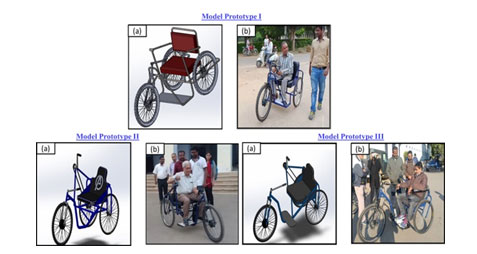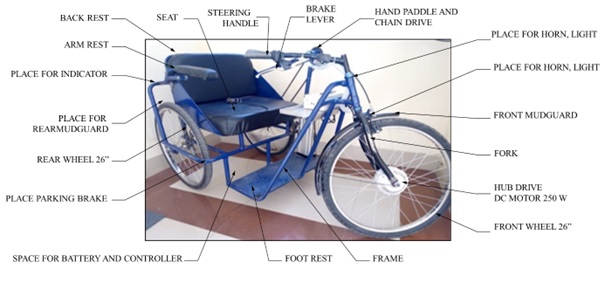
Despite many technological advancements, an economical hand-powered tricycle is still widely used by the differently abled persons (DAP) in India. The existing conventional tricycle requires high energy for paddling, which leads to an orthopedic person getting exhausted. For reducing the discomfort and fatigue of such people, there is a need to develop a power-assist hybrid e-tricycle.
Tricycles are widely used and preferred mobility options used on roads in rural and urban areas of India. The three types of tricycles commonly used are hand-driven tricycles, motorized tricycles and fully electric tricycles (FET) but there are limitations associated with each type. Hand-driven tricycle needs a lot of energy to paddle the tricycle; motorized tricycles are customized vehicles like retrofitted bikes, scooters, and cars; whereas FET-based battery-operated tricycles have options for either solar charging or electric charging. Solar-charging electric tricycle demands more surface area, cost and load the FET battery consumes lots of energy on uneven and rough surfaces and may not last long.
In comparison, a power-assistive hybrid (PAH) e-trike (electric tricycle) can reduce the battery load due to the manual power option. Hence, designing a user-friendly hybrid e-trike mobility option for locomotor DAP would ameliorate their conditions. A power-assistive hybrid (PAH) e-trike (electric tricycle), for Divyangian with impairment in the movement, has been developed at BITS Pilani in collaboration with CSIR CEERI Pilani under the scheme Technological Interventions for Disabled and Elderly (TIDE) by the Department of Science and Technology.
Need for e-tricycles in India
In India, tricycles are one of the most important modes of transportation for different abled people. Traditional tricycles are designed without much consideration for the comfort and the safety of the user. For minimizing the effort of the tricycle, there is a need for optimizing the design of the tricycle and employ a proper motor assist system. Due to the existing limitations of the traditional tricycles, new hybrid e-tricycle model has been developed with low cost, higher strength and more efficiency to make them accessible to differently-abled persons.
Achieved objectives of the BITS project:
Mathematical interpretation, ergonomic and aesthetics study of low-cost PAH e-trike.
Simulation and experimental investigation of the prototype to obtain optimized efficiency, power requirements, motor torque, rpm and load.
Simulation and development of mobility control module (algorithms and hardware) for DC motor of PAH e-trike.
Investigation of battery performance on weather conditions, the weight of user and road conditions.
Development of fault diagnostics for safety and security purposes in e-trike using structural stability and mechanical stress analysis of e-trike frame.
Design and fabrication of the wheel, spokes and DC motor assembly, other required assemblies.
Dynamic testing to control stability, easy manoeuvring, testing and controlling of brakes.
Testing of the prototypes of PAH e-Trike for the locomotor DAPs in rural and urban areas of India.
Image: Developed different designs and prototypes of PAH e-trike.

Image: Parts and accessories for PAH e-trike
Optimized dimension and working specifications
| Specification | Values |
| Speed | ~20 Km/hr |
| Run in full-charged battery | 12 to 15 Km |
| Battery – lead acid / Li-Ion | 24Volt, 7Ah |
| Controller – drive | Open loop - soft start |
| Power | 250Watt |
| Wheel track | ~1.200 m |
| Wheelbase | ~0.750 m |
| Turning radius | ~1.856 m |
| Wheel Size (diameter) | ~0.660 m |
| Ground clearance | ~6 Inches |
| Frame weight | ~ 10.5 Kg |
| Gross weight (Inc. driver) | ~120 Kg |
| Price (Total) | Rs. 18000/- |
| Brake-up of the total price | |
| Battery | Rs. 7000/- |
| Motor and control system - | Rs. 6000/- |
| Mechanical parts and accessories- | Rs. 5000/- |
Link to the video: https://youtu.be/02F7MVdIVS0
You Might Also Like
- BITS to Baker Hughes: Shad Hussain’s Journey Through Turbulent Times
- Be Cool: Navigating Life, Literature, and Mental Health with Shashi Warrier
- Coaching Across Cultures: Brajesh Bajpai’s Journey of Learning, Leading, and Adapting
- From Engineer to AI Leader: An Interview with Akhil Singhal on Startups, Strategy, and the Future of Gen A
- From Circuits to Capital Markets: Deepak Joshi’s Global Finance Journey














